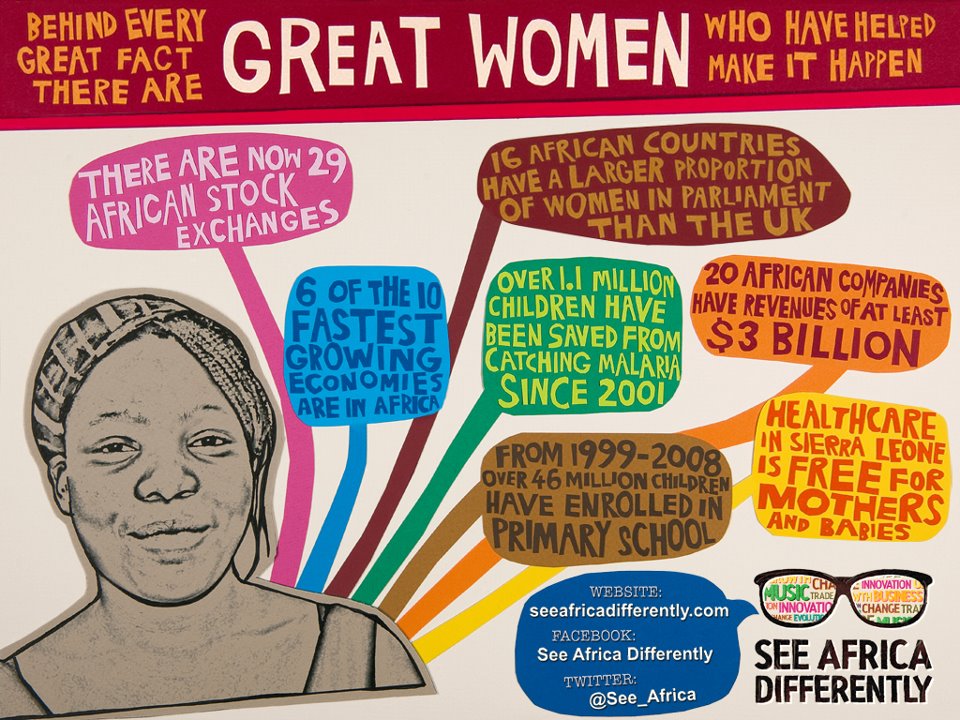Reposting this in honor of International Women’s Day and to welcome new readers wanting to think deeper about Invisible Children’s #StopKony Campaign…Check out the great graphic from See Africa Differently at the end!
***
When girls are educated, healthy, and safe, their own life prospects are transformed. And importantly, they transfer those benefits to their future families and their communities. When girls have access to opportunity, they spur social change and positive economic development. This echo into future generations is The Girl Effect.
Although more people are making strategic and significant investments in programs focused on adolescent girls, a significant proportion of these funds remain targeted at large international organizations. Certainly larger programs, policy efforts, and economic reforms are needed to bring about structural change at national and international levels.
However without building a base of committed stakeholders at all levels—in particular the local level—change runs the risk of being inconsequential in the everyday lives of girls.
Individual and institutional donors can avoid this by investing in grassroots organizations—powerful actors that are finding and reaching marginalized girls and unlocking their potential. Grassroots organizations are reaching a demographic of extremely vulnerable and hard-to-reach girls through homegrown, targeted, and context-specific strategies.
Most importantly, grassroots organizations are made up of people who are on the ground, using their local resources including time, ingenuity, and perseverance—with often very limited funding—to ensure that girls receive the opportunities they deserve.
How do grassroots organizations reach marginalized girls?
Grassroots organizations are part of the social fabric of the community in which girls live and grow. This uniquely positions them to serve and be led by vulnerable, unreached, and marginalized girls who, for example, are sexually exploited, girls with disabilities, out-of-school girls, girls who live or work on the streets, single mothers, and sexual assault and incest survivors. Their positioning also makes grassroots organizations well-suited to find and serve girls from groups that face discrimination or may be less visible, including ethnic and religious minorities, girls living in slum and squatter communities, refugees, migrants, and internally-displaced persons.
Grassroots organizations are often the “first responders,” addressing girls’ immediate and long-term needs. When election-related violence breaks out, an earthquake hits, or a case of abuse is discovered, grassroots organizations can snap into action to make sure girls are safe and cared for. They demonstrate a resourcefulness and commitment to girls that stems from their “staying power” at the local level. They leverage locally-available human, material, and financial resources to bring about durable change for girls.
What are grassroots organizations’ key strengths in reaching girls?
Contextual Expertise – As locally-rooted institutions, grassroots organizations have vital expertise in the interpersonal and caring relationships in a girl’s everyday life. Their day-to-day interactions with marginalized girls and their families, along with language and cultural skills, allow grassroots organizations a deeper understanding of how girls cope and the social fabric surrounding girls than any other development actor.
This intimate position within girls’ lives and in the community enables grassroots organizations to (1) have the legitimacy and trust to reach marginalized and isolated girls with supportive and appropriate care, (2) design programs that are deemed most necessary and sensible in their locality, and (3) use their expertise to influence local support systems and institutions (e.g. families, schools, etc.) to more adequately fulfill girls’ rights.

Continuity– Large development projects led by governments, international aid agencies, and foundations reach girls, but they often come with a narrow focus, restrictions on how the funding can be used, and fixed time frames. However, grassroots organizations have the direct and lasting relationships needed to support a girl throughout her journey to womanhood. Grassroots organizations staff and volunteers often know the girls they serve on a one-on-one basis, resulting in a very personal stake and a long-term commitment to the success of their efforts to empower girls.
Connectedness – Embedded in the community, grassroots organizations can help girls develop a genuine sense of belonging, self-esteem, leadership, and ownership that enables girls to expand their intimate circles of support. Girls who have connections to each other and beyond their own families are healthier, physically and mentally, and are more able and willing to make positive changes in their lives.
Despite these competencies, grassroots groups face a formidable challenge; they must continually seek out and compete for new resources in a funding environment that is often led by global trends rather than persistent, ongoing development challenges and that favors short-term grants to larger, higher-profile groups. Yet effective grassroots organizations are continually overwhelmed with community demand for their programs.
I’ve had the privilege of working with over 300 grassroots organizations in southern and east Africa during my career. Most were linked to local churches, schools, or clinics or were independent groups that assist children by extending support and services into areas that are not sufficiently reached by government or international agencies. In my experience, grassroots groups are there, directly working on the ground with girls, families, and communities whether outside support is available or not.
My experience also shows me that funding grassroots organizations can start small and grow with the groups as they develop, based on an in-depth understanding of the organizations, the people who make them up, and most importantly, the girls they serve.
So how do donors reach grassroots organizations? See Part 2 here.
***
***
Related Posts
Waiting for Pennies From Heaven
The Marginalization of CBOs by Development Actors: A Perspective from Zimbabwe


Dear Sir/ Madam,
We greet you for the first time.we are the world youth for humanity a youth humanitarian volunteers network organization that is dealing with adolocent girls who are not in school and who want to go to school.we want to serve as a networking partner for you in our country Liberia.We also want to attend any of your up coming program.we are also asking you to establish one of your branch here.
We also want to serve as a volunteers for you.We are kindly asking you to please support our adolocent back to school projects.
Thanks
Francis l.Roberts IV
Executive Director
Cell+231-776266201
Pingback: A new venture for girls: Can we change the world through business? – Bonfire Impact